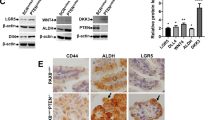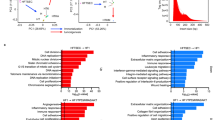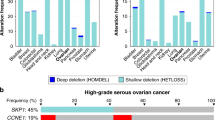Abstract
Serous ovarian carcinoma is the most lethal gynecological malignancy in Western countries. The molecular events that underlie the development of the disease have been elusive for many years. The recent identification of the fallopian tube secretory epithelial cells (FTSECs) as the cell-of-origin for most cases of this disease has led to studies aimed at elucidating new candidate therapeutic pathways through profiling of normal FTSECs and serous carcinomas. Here we describe the results of transcriptional profiles that identify the loss of the tumor suppressive transcription factor FOXO3a in a vast majority of high-grade serous ovarian carcinomas. We show that FOXO3a loss is a hallmark of the earliest stages of serous carcinogenesis and occurs both at the DNA, RNA and protein levels. We describe several mechanisms responsible for FOXO3a inactivity, including chromosomal deletion (chromosome 6q21), upregulation of miRNA-182 and destabilization by activated PI3K and MEK. The identification of pathways involved in the pathogenesis of ovarian cancer can advance the management of this disease from being dependant on surgery and cytotoxic chemotherapy alone to the era of targeted therapy. Our data strongly suggest FOXO3a as a possible target for clinical intervention.
This is a preview of subscription content, access via your institution
Access options
Subscribe to this journal
Receive 50 print issues and online access
$259.00 per year
only $5.18 per issue
Buy this article
- Purchase on Springer Link
- Instant access to full article PDF
Prices may be subject to local taxes which are calculated during checkout






Similar content being viewed by others
References
Yap TA, Carden CP, Kaye SB . Beyond chemotherapy: targeted therapies in ovarian cancer. Nat Rev Cancer 2009; 9: 167–181.
Levanon K, Crum C, Drapkin R . New insights into the pathogenesis of serous ovarian cancer and its clinical impact. J Clin Oncol 2008 10; 26: 5284–5293.
Kindelberger DW, Lee Y, Miron A, Hirsch MS, Feltmate C, Medeiros F et al. Intraepithelial carcinoma of the fimbria and pelvic serous carcinoma: Evidence for a causal relationship. Am J Surg Pathol 2007; 31: 161–169.
Medeiros F, Muto MG, Lee Y, Elvin JA, Callahan MJ, Feltmate C et al. The tubal fimbria is a preferred site for early adenocarcinoma in women with familial ovarian cancer syndrome. Am J Surg Pathol 2006; 30: 230–236.
Lee Y, Miron A, Drapkin R, Nucci MR, Medeiros F, Saleemuddin A et al. A candidate precursor to serous carcinoma that originates in the distal fallopian tube. J Pathol 2007; 211: 26–35.
Trotman LC, Alimonti A, Scaglioni PP, Koutcher JA, Cordon-Cardo C, Pandolfi PP . Identification of a tumour suppressor network opposing nuclear Akt function. Nature 2006; 441: 523–527.
Fu Z, Tindall DJ . FOXOs, cancer and regulation of apoptosis. Oncogene 2008; 27: 2312–2319.
Barreyro FJ, Kobayashi S, Bronk SF, Werneburg NW, Malhi H, Gores GJ . Transcriptional regulation of Bim by FoxO3A mediates hepatocyte lipoapoptosis. J Biol Chem 2007; 282: 27141–27154.
Greer EL, Oskoui PR, Banko MR, Maniar JM, Gygi MP, Gygi SP et al. The energy sensor AMP-activated protein kinase directly regulates the mammalian FOXO3 transcription factor. J Biol Chem 2007; 282: 30107–30119.
Willcox BJ, Donlon TA, He Q, Chen R, Grove JS, Yano K et al. FOXO3A genotype is strongly associated with human longevity. Proc Natl Acad Sci USA 2008; 105: 13987–13992.
Calnan DR, Brunet A . The FoxO code. Oncogene 2008; 27: 2276–2288.
Yang JY, Zong CS, Xia W, Yamaguchi H, Ding Q, Xie X et al. ERK promotes tumorigenesis by inhibiting FOXO3a via MDM2-mediated degradation. Nat Cell Biol 2008; 10: 138–148.
Wang F, Nguyen M, Qin FX, Tong Q . SIRT2 deacetylates FOXO3a in response to oxidative stress and caloric restriction. Aging Cell 2007; 6: 505–514.
Nakamura T, Sakamoto K . Forkhead transcription factor FOXO subfamily is essential for reactive oxygen species-induced apoptosis. Mol Cell Endocrinol 2008; 281: 47–55.
Rathbone CR, Booth FW, Lees SJ . FoxO3a preferentially induces p27Kip1 expression while impairing muscle precursor cell-cycle progression. Muscle Nerve 2008; 37: 84–89.
McGovern UB, Francis RE, Peck B, Guest SK, Wang J, Myatt SS et al. Gefitinib (Iressa) represses FOXM1 expression via FOXO3a in breast cancer. Mol Cancer Ther 2009; 8: 582–591.
Carter ME, Brunet A . FOXO transcription factors. Curr Biol 2007; 17: R113–R114.
Fei M, Zhao Y, Wang Y, Lu M, Cheng C, Huang X et al. Low expression of Foxo3a is associated with poor prognosis in ovarian cancer patients. Cancer Invest 2009; 27: 52–59.
Lu M, Zhao Y, Xu F, Wang Y, Xiang J, Chen D . The expression and prognosis of FOXO3a and Skp2 in human ovarian cancer. Med Oncol 2012; 29: 3409–3415.
Hu MC, Lee DF, Xia W, Golfman LS, Ou-Yang F, Yang JY et al. IkappaB kinase promotes tumorigenesis through inhibition of forkhead FOXO3a. Cell 2004; 117: 225–237.
Tenbaum SP, Ordonez-Moran P, Puig I, Chicote I, Arques O, Landolfi S et al. beta-catenin confers resistance to PI3K and AKT inhibitors and subverts FOXO3a to promote metastasis in colon cancer. Nat Med 2012; 18: 892–901.
Kim W, Youn H, Kwon T, Kang J, Kim E, Son B et al. PIM1 kinase inhibitors induce radiosensitization in non-small cell lung cancer cells. Pharmacol Res 2013; 70: 90–101.
Yamaguchi H, Hsu JL, Chen CT, Wang YN, Hsu MC, Chang SS et al. Caspase-independent cell death is involved in the negative effect of EGF receptor inhibitors on cisplatin in non-small cell lung cancer cells. Clin Cancer Res 2013; 19: 845–854.
Kornblau SM, Singh N, Qiu Y, Chen W, Zhang N, Coombes KR . Highly phosphorylated FOXO3A is an adverse prognostic factor in acute myeloid leukemia. Clin Cancer Res 2010; 16: 1865–1874.
Osuka S, Sampetrean O, Shimizu T, Saga I, Onishi N, Sugihara E et al. IGF1 receptor signaling regulates adaptive radioprotection in glioma stem cells. Stem Cells 2013; 31: 627–640.
Santo EE, Stroeken P, Sluis PV, Koster J, Versteeg R, Westerhout EM . FOXO3a is a major target of inactivation by PI3K/AKT signaling in aggressive neuroblastoma. Cancer Res 2007; 73: 2189–2198.
Myatt SS, Lam EW . The emerging roles of forkhead box (Fox) proteins in cancer. Nat Rev Cancer 2007; 7: 847–859.
Gomes AR, Brosens JJ, Lam EW . Resist or die: FOXO transcription factors determine the cellular response to chemotherapy. Cell Cycle 2008; 7: 3133–3136.
Su JL, Cheng X, Yamaguchi H, Chang YW, Hou CF, Lee DF et al. FOXO3a-Dependent mechanism of E1A-induced chemosensitization. Cancer Res 2011; 71: 6878–6887.
Zhao F, Lam EW . Role of the forkhead transcription factor FOXO-FOXM1 axis in cancer and drug resistance. Front Med 2012; 6: 376–380.
Karst AM, Drapkin R . Primary culture and immortalization of human fallopian tube secretory epithelial cells. Nat Protoc 2012; 7: 1755–1764.
Karst AM, Levanon K, Drapkin R . Modeling high-grade serous ovarian carcinogenesis from the fallopian tube. Proc Natl Acad Sci USA 2011; 108: 7547–7552.
Cerami E, Gao J, Dogrusoz U, Gross BE, Sumer SO, Aksoy BA et al. The cBio cancer genomics portal: an open platform for exploring multidimensional cancer genomics data. Cancer Discov 2012; 2: 401–404.
Kuhn RM, Karolchik D, Zweig AS, Wang T, Smith KE, Rosenbloom KR et al. The UCSC Genome Browser Database: update 2009. Nucleic Acids Res 2009; 37 (Database issue): D755–D761.
Schlesinger Y, Straussman R, Keshet I, Farkash S, Hecht M, Zimmerman J et al. Polycomb-mediated methylation on Lys27 of histone H3 pre-marks genes for de novo methylation in cancer. Nat Genet 2007; 39: 232–236.
Bracken AP, Dietrich N, Pasini D, Hansen KH, Helin K . Genome-wide mapping of Polycomb target genes unravels their roles in cell fate transitions. Genes Dev 2006; 20: 1123–1136.
Mikkelsen TS, Ku M, Jaffe DB, Issac B, Lieberman E, Giannoukos G et al. Genome-wide maps of chromatin state in pluripotent and lineage-committed cells. Nature 2007; 448: 553–560.
Segura MF, Hanniford D, Menendez S, Reavie L, Zou X, Alvarez-Diaz S et al. Aberrant miR-182 expression promotes melanoma metastasis by repressing FOXO3 and microphthalmia-associated transcription factor. Proc Natl Acad Sci USA 2009; 106: 1814–1819.
Saal LH, Johansson P, Holm K, Gruvberger-Saal SK, She QB, Maurer M et al. Poor prognosis in carcinoma is associated with a gene expression signature of aberrant PTEN tumor suppressor pathway activity. Proc Natl Acad Sci USA 2007; 104: 7564–7569.
Jarboe EA, Folkins AK, Drapkin R, Ince TA, Agoston ES, Crum CP . Tubal and ovarian pathways to pelvic epithelial cancer: a pathological perspective. Histopathology 2008; 53: 127–138.
Folkins AK, Jarboe EA, Saleemuddin A, Lee Y, Callahan MJ, Drapkin R et al. A candidate precursor to pelvic serous cancer (p53 signature) and its prevalence in ovaries and fallopian tubes from women with BRCA mutations. Gynecol Oncol 2008; 109: 168–173.
Paik JH, Kollipara R, Chu G, Ji H, Xiao Y, Ding Z et al. FoxOs are lineage-restricted redundant tumor suppressors and regulate endothelial cell homeostasis. Cell 2007; 128: 309–323.
Castrillon DH, Miao L, Kollipara R, Horner JW, DePinho RA . Suppression of ovarian follicle activation in mice by the transcription factor Foxo3a. Science 2003; 301: 215–218.
Potente M, Urbich C, Sasaki K, Hofmann WK, Heeschen C, Aicher A et al. Involvement of Foxo transcription factors in angiogenesis and postnatal neovascularization. J Clin Invest 2005; 115: 2382–2392.
Dejean AS, Beisner DR, Ch'en IL, Kerdiles YM, Babour A, Arden KC et al. Transcription factor Foxo3 controls the magnitude of T cell immune responses by modulating the function of dendritic cells. Nat Immunol 2009; 10: 504–513.
Hahn WC, Dessain SK, Brooks MW, King JE, Elenbaas B, Sabatini DM et al. Enumeration of the simian virus 40 early region elements necessary for human cell transformation. Mol Cell Biol 2002; 22: 2111–2123.
Firestein R, Bass AJ, Kim SY, Dunn IF, Silver SJ, Guney I et al. CDK8 is a colorectal cancer oncogene that regulates beta-catenin activity. Nature 2008; 455: 547–551.
Acknowledgements
This work was supported by research grants from the National Institutes of Health/National Cancer Institute (P50 CA105009, U01 CA152990, and R21 CA156021), the Ovarian Cancer Research Fund, The Mary Kay Foundation, The Tina Brozman Foundation, The Robert and Debra First Fund, the Gamel Family Fund for Ovarian Cancer, the Marsha Rivkin Foundation Scientific Scholar Award, the AACR- George and Patricia Sehl Fellowship for Cancer Genetics Research, the American Physicians Fellowship for Medicine in Israel—Claire and Emmanuel G. Rosenblatt Foundation Grant, The Israel Science Foundation Legacy Heritage Clinical Research Initiative, The Israel Cancer Research Fund Clinical Research Career Development Award and the Chaim Sheba Medical Center Dr Pinchas Bornstein Talpiot Medical Leadership Program.We thank Drs. John Quackenbush, Massimo Loda, Keith Ligon and Sekhar Duraisamy, Dana-Farber Cancer Institute, for their suggestions and generous assistance with reagents and bioinformatics; Dr Ravid Straussman, the Broad Institute, for his guidance with methylation detection; Dr Sol Efroni and Rotem Ben-Hamo, Bar llan University, Israel, for bioinformatic support; and The Chaim Sheba Tissue Bank.
DISCLAIMER
Some results published here are based upon data generated by The Cancer Genome Atlas Pilot Project (http://cancergenome.nih.gov).
Author information
Authors and Affiliations
Corresponding author
Ethics declarations
Competing interests
The authors declare no conflict of interest.
Additional information
Supplementary Information accompanies this paper on the Oncogene website
Supplementary information
Rights and permissions
About this article
Cite this article
Levanon, K., Sapoznik, S., Bahar-Shany, K. et al. FOXO3a loss is a frequent early event in high-grade pelvic serous carcinogenesis. Oncogene 33, 4424–4432 (2014). https://doi.org/10.1038/onc.2013.394
Received:
Revised:
Accepted:
Published:
Issue Date:
DOI: https://doi.org/10.1038/onc.2013.394
Keywords
This article is cited by
-
Epigallocatechin gallate inhibits ovarian cancer cell growth and induces cell apoptosis via activation of FOXO3A
In Vitro Cellular & Developmental Biology - Animal (2023)
-
Downregulation of FOXO3a by DNMT1 promotes breast cancer stem cell properties and tumorigenesis
Cell Death & Differentiation (2020)
-
Human endometrial mesenchymal stem cells exhibit intrinsic anti-tumor properties on human epithelial ovarian cancer cells
Scientific Reports (2016)
-
Downregulation of Foxo3 and TRIM31 by miR-551b in side population promotes cell proliferation, invasion, and drug resistance of ovarian cancer
Medical Oncology (2016)



